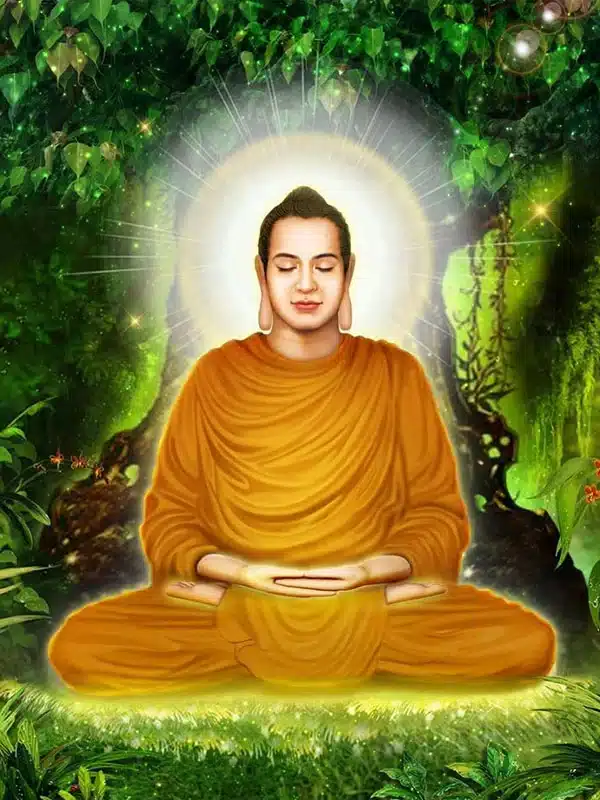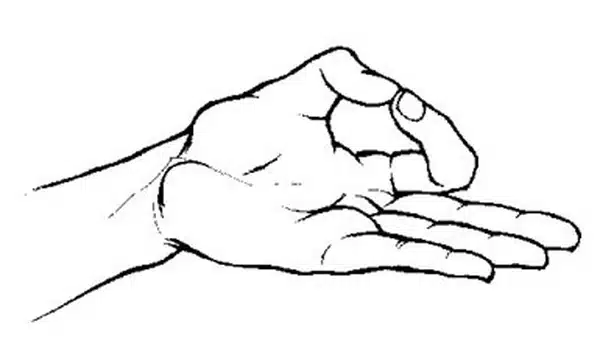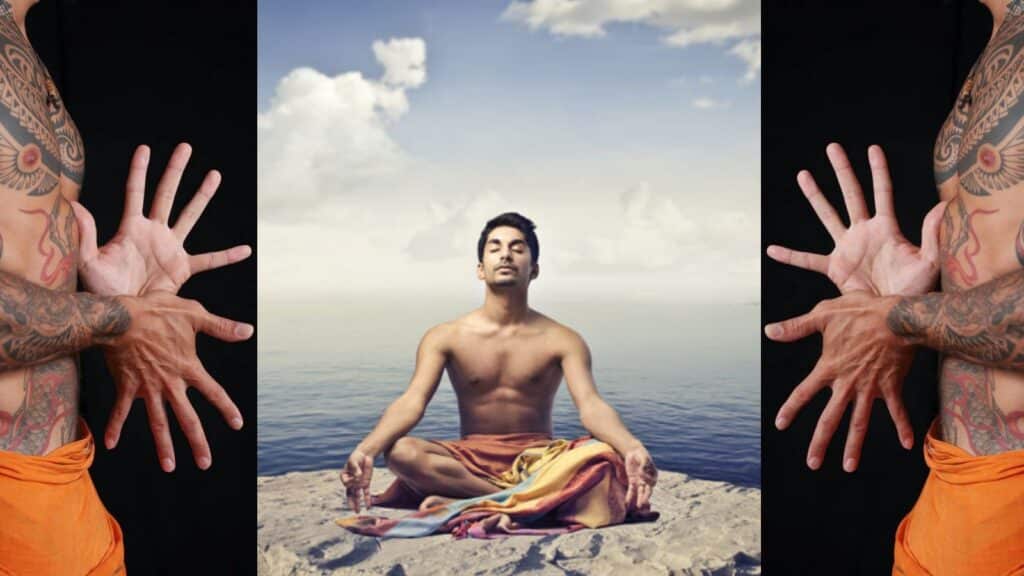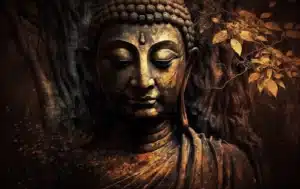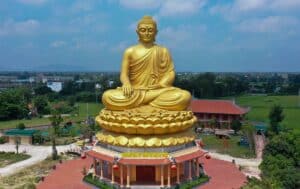When visiting Buddhist temples, you may have encountered statues of the Buddha with strange hand gestures. Well, in Buddhism and Yoga, these hand gestures are called mudras, and they represent the profound meanings of spiritual traditions.
Mudra is a type of hand gesture commonly used in Yoga combined with breathing exercises, helping to revive and circulate energy flow to different parts of the body to improve your physical health and mental well-being.
According to Vedantic tradition, the five fingers represent the five essential elements: earth, water, wind, air, and fire. The fingertips are where nerve endings are concentrated, acting as points for the release of free energy.
When the fingertips touch each other in different ways or connect to other parts of the palm, the energy flow in our body is regulated and balanced. Energy from the nerve endings is transmitted, stimulating various energy centers.
What is a Mudra?
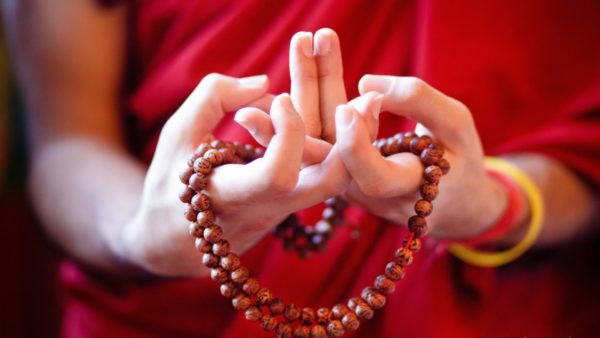
Mudra is a symbolic hand gestures used primarily in Hinduism, Buddhism and some other spiritual practices. They are believed to have spiritual, healing, and transformative powers. Mudras are often used in meditation, yoga, and traditional Indian dance forms as a way to channel energy and maintain focus.
In Buddhism, the Buddhas are often depicted with specific hand positions, usually mudras involving the fingers, and each symbol carries its own special meaning.
Additionally, a mudra is understood as the main postures that Buddha used in his daily life or, more precisely, as the postures of the Buddha. And mudras are used to describe and present the image of the Buddha.
There are 7 important mudras commonly depicted in paintings and Buddha statues:
- Dhyana Mudra
- Varada Mudra
- Abhaya Mudra
- Vitarka Mudra
- Dharmachakra Mudra
- Bhumisparsha Mudra
- Anjali Mudra
Each mudra is said to represent different qualities, emotions or states of mind and is thought to help cultivate these qualities when practiced regularly.
Moreover, mudras are not only limited to hand gestures, but can also involve the entire body or specific body parts such as the face or eyes. Practitioners believe that by incorporating mudras into their spiritual practices, they can access deeper levels of consciousness and unlock their inner potential.
History of Mudra
Mudra can be traced back thousands of years, with roots deeply entwined with the spiritual traditions of Hinduism and Buddhism. These ancient hand gestures have evolved and been passed down through generations, maintaining their significance and impact on the spiritual practices of many cultures.
In Hinduism, mudras have been an essential aspect of spiritual and religious practice since the time of Vedas, which date back to around 1500-500 BCE. These sacred texts contain references to the use of mudras in rituals, meditation, and dance. The Hindu gods and goddesses are often depicted with specific mudras that symbolize their unique attributes and powers.
The statue of the Buddha sitting in meditation, forming a mudra with both hands placed in the lap, the back of the right hand resting on the palm of the left hand, with the two index fingers touching each other lightly. The Buddha used this mudra to focus his profound thoughts, symbolizing the wisdom that has reached the realm of enlightenment, escaping from the world of phenomena and the consciousness of distinguishing right from wrong. This mudra helped the Buddha attain enlightenment during his final meditation under the Bodhi tree.
In Buddhism, mudras are believed to have been utilized and taught by the Buddha himself. They are integral to various Buddhist practices, such as meditation and deity visualization of Tantric Buddhism. Many statues and images of the Buddha, bodhisattvas, and other enlightened beings display specific mudras, which symbolize different aspects of their teachings or states of mind.
Mudras also found their way into traditional Indian dance forms, such as Bharatanatyam and Odissi. These classical dances use an elaborate vocabulary of hand gestures, or “hasta mudras,” to convey emotions, stories, and spiritual concepts. The Natya Shastra, an ancient Indian treatise on performing arts, describes the various mudras and their meanings in great detail.
The practice of mudras has spread beyond India and can be found in other spiritual and cultural traditions, such as Tibetan Buddhism and various forms of Japanese and Chinese Buddhism. In recent years, the popularity of yoga and meditation has introduced mudras to a broader global audience, allowing people from various walks of life to experience their transformative power.
Throughout their long history, mudras have been revered as a powerful means to access and cultivate spiritual energy. Their continued use and relevance today are a testament to the timeless wisdom that they embody.
How do Mudras Work?
When we practice mudras, we create an energetic circuit within ourselves, balancing and redirecting the flow of prana or life force energy. As we mindfully hold these gestures, the universe smiles upon us, guiding our consciousness to a deeper state of awareness.
The secret of mudras lies in their simplicity. With just a gentle touch of the fingertips or a delicate arrangement of hands, we can tap into the vast expanse of our inner wisdom. It’s like a gentle breeze that guides a leaf to the ground, knowing precisely where it needs to land.
As we incorporate mudras into our meditation or yoga practices, we find that our minds become calmer, our hearts more compassionate, and our spirits more attuned to the world around us. Each mudra has its unique energy, much like the beautiful flowers in a blossoming garden. Like the Buddha himself, who sat beneath the Bodhi tree and reached enlightenment, you too may find that these sacred gestures guide you on your path to awakening.
Meanings and Benefits of Each Type of Mudra
As LotusBuddhas has shared, each mudra carries its own meaning and energy. By forming hand gestures according to each mudra, practitioners during meditation and yoga can receive the health benefits associated with them.
These sacred hand gestures are believed to work on subtle levels, harmonizing the flow of prana or life force energy, within our body, mind and spirit. Like a master healer, mudras can help address various health issues, bringing balance and vitality to our lives.
However, LotusBuddhas also notes that mudras should be considered as a supplementary practice and not a substitute for professional advice or medical treatment.
1. Gyan Mudra
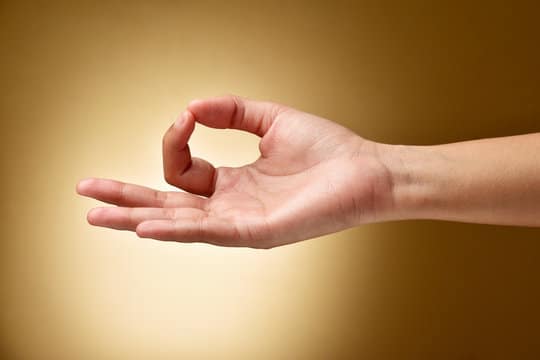
This mudra is the key to knowledge and wisdom. By connecting the tip of the index finger to the tip of the thumb, we ignite the fire of understanding within us. The Gyan Mudra helps sharpen the mind, allowing us to see the world with clarity and insight.
2. Anjali Mudra
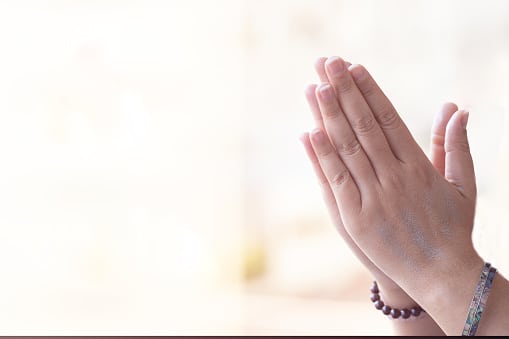
With hands pressed together at the heart, the Anjali Mudra speaks the language of love and devotion. It reminds us to approach life with humility and gratitude, like a lotus flower bowing to the sun.
3. Dhyana Mudra

As we sit in meditation, our hands rest gently in our lap, one atop the other, with thumbs touching. This is the Dhyana Mudra, a gesture of deep concentration and inner peace. It helps to still the mind, like a calm lake reflecting the moon’s light.
4. Abhaya Mudra

Abhaya Mudra brings protection and courage. With the right hand raised, palm facing outward, we stand strong like a mountain, unshaken by the storms of life. This mudra fosters a sense of inner security and fearlessness.
5. Prana Mudra

To cultivate the life force within us, we practice the Prana Mudra. Touching the tips of the ring finger and pinky finger to the tip of the thumb, we create a reservoir of life force energy that can help alleviate fatigue and support overall well-being.
6. Apana Mudra

This powerful mudra is said to aid in digestion and detoxification. By connecting the tips of the middle and ring fingers to the thumb, we encourage the downward flow of energy, promoting elimination and purification.
7. Surya Mudra

This mudra, associated with the sun’s energy, is believed to help with weight management and metabolism. By placing the tip of the ring finger under the base of the thumb, we ignite the fire element within us, encouraging balance and transformation.
8. Ganesha Mudra

For those who seek strength and courage in the face of obstacles, the Ganesha Mudra can offer support. By clasping your hands in front of your chest, with your left palm facing outwards and your right palm facing inwards, you evoke the power and determination of the elephant-headed deity Ganesha.
9. Shunya Mudra

For those who experience issues with their ears or a sense of imbalance, the Shunya Mudra may provide relief. By gently pressing the middle finger to the base of the thumb and keeping the other fingers extended, we create a sense of space and openness, inviting healing energy to flow.
Benefits of Practicing Mudras

The combination of mudras with yoga and meditation practices is increasingly becoming popular. Many people believe that it brings greater benefits to their practices. In the final part of this article, LotusBuddhas will discuss scientific research on the benefits of mudras. For now, let’s continue to explore the practical benefits that mudras bring, as shared by many students.
1. Balance and harmony
As we engage in mudras, we create an energetic circuit within our being, connecting our body, mind, and spirit. This delicate dance of energy helps us find balance and harmony, like the sun and the moon in a celestial embrace.
2. Enhanced focus and concentration
Mudras act as anchors for our wandering minds, guiding us gently back to the present moment. They sharpen our focus and deepen our concentration, allowing us to embrace the beauty and wisdom of stillness.
3. Emotional healing and stability
The practice of mudras can soothe our turbulent emotions and foster inner peace. By holding these sacred gestures, we invite tranquility into our hearts, like a cool breeze on a warm summer’s day.
4. Stress reduction and relaxation
In our busy lives, we often carry the weight of the world on our shoulders. Mudras help us release these burdens, guiding us into a state of deep relaxation and serenity.
5. Spiritual growth and self-awareness
Mudras are windows to our inner selves, revealing the hidden depths of our consciousness. By incorporating them into our spiritual practices, we cultivate self-awareness and foster our growth along the path of enlightenment.
How to Practice Mudras
By now, you probably know what mudras are, right? LotusBuddhas is confident that in your mind, you are eager to learn how to practice mudras accurately to unlock the door to your deepest spiritual potential and wisdom.
1. Choose your mudra: Begin by selecting a mudra that resonates with your current needs or spiritual aspirations. Each mudra holds its unique energy and purpose, like the many flowers that adorn a blossoming garden.
2. Find a comfortable seat: Sit down in a quiet and serene space, adopting a comfortable posture that allows your spine to be upright and your body to be at ease. You may choose to sit cross-legged on the floor, in a chair, or even on a cushion.
3. Relax your body: Take a moment to bring awareness to your body, gently releasing any tension or tightness. Like a tree rooted in the earth, allow yourself to be firmly grounded while remaining flexible and open to the flow of energy.
4. Position your hands: Gently form the mudra with your hands, mindful of the alignment and positioning of your fingers and palms. Hold the mudra with a sense of reverence and grace, as if cradling a precious gem.
5. Breathe mindfully: Draw your attention to your breath, allowing it to flow naturally and effortlessly. As you inhale and exhale, imagine the breath as a river of energy, nourishing and cleansing your body, mind, and spirit.
6. Meditate with the mudra: Holding the mudra, close your eyes and enter a state of meditation, focusing on the energy and intention of the gesture. Allow the mudra to be your anchor, guiding your awareness inward and cultivating a deep sense of presence.
7. Practice regularly: Like tending to a garden, the practice of mudras requires consistency and patience. Set aside time each day to engage with these sacred gestures, nurturing your inner landscape and reaping the benefits they bestow.
Scientific Studies Support the Effectiveness of Mudras
In our modern world, the thirst for scientific validation often guides our journey toward truth and knowledge. While the practice of mudras has its roots in ancient spiritual traditions, modern scientific studies have indeed begun to explore their potential effects on our well-being.
Many studies have focused on the broader practice of yoga and meditation, which often incorporate mudras as an essential element. These studies have shown numerous benefits, such as stress reduction, improved focus, and emotional stability, which may be linked to the practice of mudras as well.
Some studies have specifically examined the effects of mudras on various aspects of health. For example, research on the Gyan Mudra, which involves connecting the tip of the index finger to the tip of the thumb, has suggested that it may help improve cognitive function and memory.
Another study on the Prana Mudra, where the tips of ring finger and pinky finger touch the tip of the thumb, has shown potential benefits for those experiencing fatigue, as it is believed to stimulate the flow of energy in the body.
However, scientific research on mudras is still in its early stages and further comprehensive studies are needed to fully understand their effects. Nevertheless, there is much evidence that mudras can indeed have positive impacts on our overall health.
LotusBuddhas always reminds its readers that when encountering a new concept or a new practice, we should approach them with an open heart and a clear mind. Let your own personal experience lead to your final conclusion.
Note: You can refer to more scientific studies on the effect of Yoga mudras in improving health on the National Library of Medicine’s website: https://www.ncbi.nlm.nih.gov/pmc/articles/PMC9347266/


